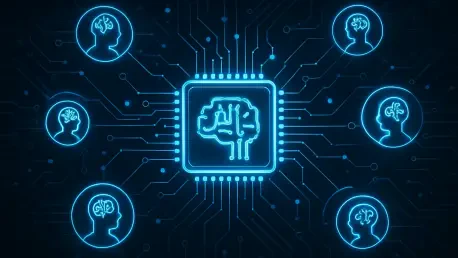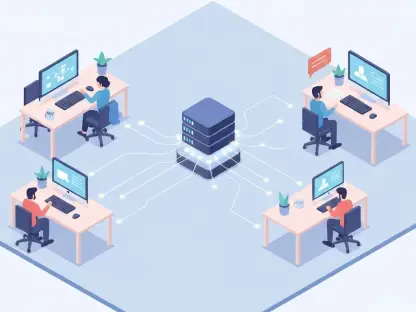The tech industry is witnessing a profound transformation as decentralized AI emerges as a formidable force, shaking the foundations of dominance held by major cloud providers like Amazon Web Services, Google Cloud, and Microsoft Azure. For years, these giants have controlled the AI landscape through their sprawling data centers and proprietary systems, setting high barriers for entry with costly infrastructure demands. Now, a groundbreaking innovation is rewriting the rules, slashing costs dramatically, accelerating processes, and opening doors for a wider array of participants to engage in AI development. This shift transcends mere technological advancement; it represents a structural overhaul with implications that ripple across economic, competitive, and even geopolitical spheres. As the balance of power tilts, the question looms large: can the big cloud titans adapt to a world where AI is no longer their exclusive domain, or will they be outpaced by a more inclusive, distributed future?
Unpacking the Technological Breakthrough
The catalyst for this upheaval is the DiLoCoX framework, a pioneering solution developed through a collaboration between 0G Labs and China Mobile. This framework achieves the seemingly impossible—training AI models with over 100 billion parameters on networks as modest as a standard 1 Gbps connection, comparable to typical office internet speeds. By leveraging advanced techniques such as pipeline parallelism and adaptive gradient compression, it reduces training costs by up to 95% and accelerates the process by 300 times compared to conventional methods. This eliminates the dependency on expensive GPU clusters and high-bandwidth networks, which have long been the gatekeepers of AI innovation. For industries like healthcare and finance, where data privacy is paramount, the trustless design of DiLoCoX offers a compelling alternative, mitigating risks of breaches and vendor lock-in that plague centralized cloud systems.
Beyond its technical feats, the DiLoCoX framework redefines what is possible in AI development by addressing systemic inefficiencies that have favored only the largest players. Its ability to function in low-bandwidth environments means that cutting-edge AI is no longer confined to tech hubs with access to top-tier infrastructure. This opens up new possibilities for organizations in remote or less-resourced regions to participate in the AI race. Moreover, the framework’s emphasis on delay-tolerant communication ensures that even intermittent network issues do not derail progress, making it a robust solution for diverse operational contexts. As a result, the technology not only challenges the economic model of big cloud providers but also sets a new standard for resilience and accessibility in AI training, prompting a reevaluation of how computational resources are allocated and utilized across the industry.
Broadening Access to AI Innovation
One of the most transformative aspects of this decentralized approach is its democratization of AI capabilities. By drastically lowering the financial and technical barriers, DiLoCoX empowers a wide range of entities—from nimble startups to mid-sized enterprises and even governments in developing nations—to engage in large-scale AI projects. Previously, the prohibitive costs of infrastructure meant that only deep-pocketed corporations could afford to compete in this space. Now, with a framework that operates efficiently on modest networks, smaller players can develop sophisticated models without the burden of massive capital investment. This shift fosters a surge of innovation as diverse perspectives and needs drive the creation of tailored AI solutions, challenging the one-size-fits-all offerings of traditional cloud giants.
This democratization also has strategic implications for industries under strict regulatory oversight. Sectors such as defense and finance, which have historically hesitated to fully embrace centralized cloud solutions due to concerns over data security, find a viable path forward with decentralized frameworks. The trustless architecture ensures that sensitive information remains protected, reducing reliance on external providers whose priorities may not align with those of their clients. As a result, the technology not only levels the playing field but also reshapes competitive dynamics, enabling entities to prioritize sovereignty over their data while still harnessing the power of AI. This trend signals a broader cultural shift in the tech ecosystem, where access and control are no longer dictated by a handful of dominant players but are distributed across a more inclusive network of innovators.
Fueling a New Wave of Investment
The financial world has taken notice of the potential unleashed by decentralized AI, with significant capital flowing into startups that champion distributed computing ecosystems. Companies like Nirvana Labs and Prime Intellect have secured substantial funding in recent months, reflecting strong confidence from venture capital firms in the viability of these technologies. Investors, including prominent names like Hack VC, are increasingly placing bets on a future where AI development is not monopolized by centralized data centers but thrives in a collaborative, decentralized environment. This investment surge underscores a pivotal shift in market sentiment, as stakeholders recognize that the next frontier of technological growth lies in empowering a broader base of contributors rather than reinforcing existing hierarchies.
The momentum behind decentralized AI also highlights the economic opportunities tied to this paradigm shift. As funding rounds multiply, they catalyze further innovation, enabling startups to scale solutions like DiLoCoX and explore new applications across diverse sectors. This creates a virtuous cycle where increased investment drives technological advancements, which in turn attract more capital. However, the challenge for investors lies in navigating the volatility of a rapidly evolving landscape, where success depends on identifying scalable platforms that can withstand both technical and external pressures. The financial backing of decentralized AI signals a transformative moment, suggesting that the industry is on the cusp of a structural realignment where distributed systems could redefine the economics of technology development for years to come.
Navigating Geopolitical Complexities
While the technological and economic impacts of decentralized AI are profound, they are not without significant challenges, particularly on the geopolitical front. The collaboration behind DiLoCoX, involving a state-affiliated telecom giant like China Mobile, has sparked concerns in the U.S. and allied nations about national security and regulatory alignment. Despite the framework’s privacy-focused architecture, which aims to safeguard data through trustless mechanisms, the involvement of a Chinese entity introduces risks of scrutiny and potential restrictions. Western governments, prioritizing tech dominance as a strategic imperative, may impose export controls or other barriers, complicating the adoption of such frameworks in their markets and casting a shadow over international partnerships.
These geopolitical tensions are further amplified by differing visions for AI governance on the global stage. While some nations advocate for cooperative frameworks to standardize AI development, others view the technology as a battleground for influence, prioritizing control over collaboration. For companies looking to integrate decentralized solutions, this creates a complex landscape where innovation must be balanced against compliance with varying legal and political expectations. The uncertainty surrounding cross-border collaborations could slow the global rollout of technologies like DiLoCoX, even as their potential to reshape the industry remains undeniable. As such, stakeholders must tread carefully, weighing the benefits of cutting-edge tools against the backdrop of international rivalries that could redefine the rules of engagement in the tech sector.
Shaping the Future of AI Infrastructure
Reflecting on this transformative period, it’s evident that decentralized AI has already begun to erode the stronghold of big cloud providers through innovations like the DiLoCoX framework. The dramatic reduction in costs and acceleration of training processes marked a turning point, allowing a diverse array of players to step into the AI arena. Meanwhile, substantial investments in distributed computing ecosystems underscored the market’s belief in a more inclusive tech future, even as geopolitical frictions posed notable hurdles. Looking ahead, the path forward demands a strategic approach from enterprises and investors alike. Adopting decentralized frameworks should be paired with robust risk management to address regulatory and security concerns. Collaboration across borders, while challenging, must be pursued with transparency to build trust and ensure broader adoption. Ultimately, the success of this shift will hinge on the ability to innovate responsibly, balancing technological advancement with the complexities of a globally interconnected landscape.









